The Socotra starling (Onychognathus frater) is a species of starling in the family Sturnidae. It is endemic to Socotra island,[2] which is off the southeast coast of Yemen.
| Socotra starling | |
|---|---|

| |
| Scientific classification | |
| Domain: | Eukaryota |
| Kingdom: | Animalia |
| Phylum: | Chordata |
| Class: | Aves |
| Order: | Passeriformes |
| Family: | Sturnidae |
| Genus: | Onychognathus |
| Species: | O. frater
|
| Binomial name | |
| Onychognathus frater (PL Sclater & Hartlaub, 1881)
| |
Its natural habitats are subtropical or tropical dry forest, subtropical or tropical moist lowland forest, subtropical or tropical dry shrubland, subtropical or tropical high-altitude shrubland, and rural gardens.
The Socotra starling builds its nests in the hollow branches of Socotra's dragon blood tree[3] (Dracaena cinnabari). In addition to feeding on grasshoppers and figs,[2] the bird also eats the berries of the dragon blood tree and helps disperse the tree's seeds.[4]
References
edit- ^ BirdLife International (2017). "Onychognathus frater". IUCN Red List of Threatened Species. 2017: e.T22710619A111063411. doi:10.2305/IUCN.UK.2017-1.RLTS.T22710619A111063411.en. Retrieved 12 November 2021.
- ^ a b Ripley, S. Dillon; Bond, Gorman M. (1966). "The birds of Socotra and Abd-el-Kuri". Smithsonian Miscellaneous Collections. 151 (7). ISSN 0096-8749.
- ^ Porter, R. F.; Suleiman, A. S. (2016). "The important bird and biodiversity areas of the socotra archipelago, Yemen". Sandgrouse. 38: 169–191.
- ^ Adolt, Radim; Pavlis, Jindrich (1 January 2004). "Age structure and growth of Dracaena cinnabari populations on Socotra". Trees. 18 (1): 43–53. doi:10.1007/s00468-003-0279-6. ISSN 1432-2285. S2CID 11360224.
